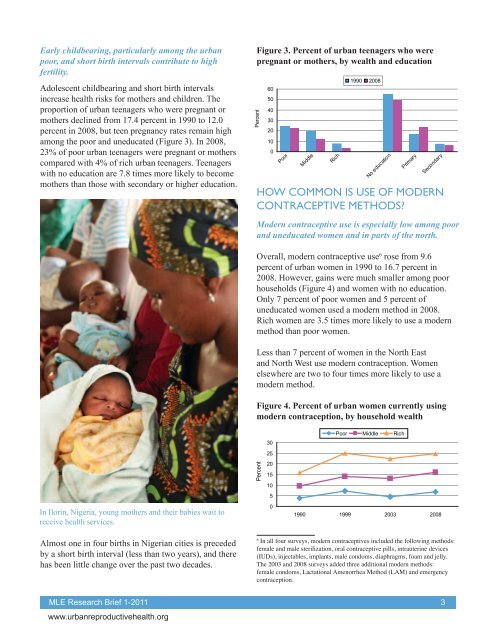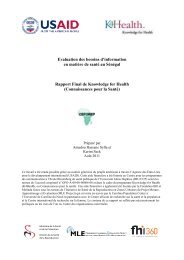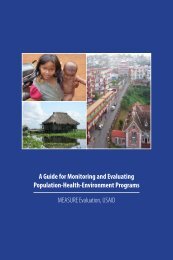fertility and family planning trends in urban nigeria: a research brief
fertility and family planning trends in urban nigeria: a research brief
fertility and family planning trends in urban nigeria: a research brief
You also want an ePaper? Increase the reach of your titles
YUMPU automatically turns print PDFs into web optimized ePapers that Google loves.
Early childbear<strong>in</strong>g, particularly among the <strong>urban</strong><br />
poor, <strong>and</strong> short birth <strong>in</strong>tervals contribute to high<br />
<strong>fertility</strong>.<br />
Adolescent childbear<strong>in</strong>g <strong>and</strong> short birth <strong>in</strong>tervals<br />
<strong>in</strong>crease health risks for mothers <strong>and</strong> children. The<br />
proportion of <strong>urban</strong> teenagers who were pregnant or<br />
mothers decl<strong>in</strong>ed from 17.4 percent <strong>in</strong> 1990 to 12.0<br />
percent <strong>in</strong> 2008, but teen pregnancy rates rema<strong>in</strong> high<br />
among the poor <strong>and</strong> uneducated (Figure 3). In 2008,<br />
23% of poor <strong>urban</strong> teenagers were pregnant or mothers<br />
compared with 4% of rich <strong>urban</strong> teenagers. Teenagers<br />
with no education are 7.8 times more likely to become<br />
mothers than those with secondary or higher education.<br />
Figure 3. Percent of <strong>urban</strong> teenagers who were<br />
Percent of <strong>urban</strong> teenagers who were<br />
pregnant or mothers, by wealth <strong>and</strong> education<br />
Percent<br />
60<br />
50<br />
40<br />
30<br />
20<br />
10<br />
0<br />
Poor<br />
pregnant or mothers, by wealth <strong>and</strong> education<br />
Middle<br />
Rich<br />
1990 2008<br />
No education<br />
Primary<br />
Secondary<br />
HOW COMMON IS USE OF MODERN<br />
CONTRACEPTIVE METHODS?<br />
Modern contraceptive use is especially low among poor<br />
<strong>and</strong> uneducated women <strong>and</strong> <strong>in</strong> parts of the north.<br />
Overall, modern contraceptive use 6 rose from 9.6<br />
percent of <strong>urban</strong> women <strong>in</strong> 1990 to 16.7 percent <strong>in</strong><br />
2008. However, ga<strong>in</strong>s were much smaller among poor<br />
households (Figure 4) <strong>and</strong> women with no education.<br />
Only 7 percent of poor women <strong>and</strong> 5 percent of<br />
uneducated women used a modern method <strong>in</strong> 2008.<br />
Rich women are 3.5 times more likely to use a modern<br />
method than poor women.<br />
Percent of <strong>urban</strong> women currently us<strong>in</strong>g modern<br />
contraception, by household wealth<br />
Less than 7 percent of women <strong>in</strong> the North East<br />
<strong>and</strong> North West use modern contraception. Women<br />
elsewhere are two to four times more likely to use a<br />
modern method.<br />
Figure 4. Percent of <strong>urban</strong> women currently us<strong>in</strong>g<br />
modern contraception, by household wealth<br />
In Ilor<strong>in</strong>, Nigeria, young mothers <strong>and</strong> their babies wait to<br />
receive health services.<br />
Percent<br />
30<br />
25<br />
20<br />
15<br />
10<br />
5<br />
0<br />
Poor Middle Rich<br />
1990 1999 2003 2008<br />
Almost one <strong>in</strong> four births <strong>in</strong> Nigerian cities is preceded<br />
by a short birth <strong>in</strong>terval (less than two years), <strong>and</strong> there<br />
has been little change over the past two decades.<br />
6<br />
In all four surveys, modern contraceptives <strong>in</strong>cluded the follow<strong>in</strong>g methods:<br />
female <strong>and</strong> male sterilization, oral contraceptive pills, <strong>in</strong>trauter<strong>in</strong>e devices<br />
(IUDs), <strong>in</strong>jectables, implants, male condoms, diaphragms, foam <strong>and</strong> jelly.<br />
The 2003 <strong>and</strong> 2008 surveys added three additional modern methods:<br />
female condoms, Lactational Amenorrhea Method (LAM) <strong>and</strong> emergency<br />
contraception.<br />
MLE Research Brief 1-2011<br />
www.<strong>urban</strong>reproductivehealth.org<br />
3














![questionnaire no: [__|__|__|__|__|__|__|__|__] - Measurement ...](https://img.yumpu.com/22729956/1/184x260/questionnaire-no-measurement-.jpg?quality=85)
![questionnaire serial no:[__|__|__|__] - Your Resource for Urban ...](https://img.yumpu.com/10870216/1/184x260/questionnaire-serial-no-your-resource-for-urban-.jpg?quality=85)